|
Broadcast tower collapse topples sister structure in Georgia demolition attempt using explosives
June 7, 2006 - What appeared to be a newly written textbook example of how to demolish a 1,000-foot-tall broadcast tower that had interlaced guy wires with another 1,000-foot tower less than 150-feet away, turned into a catastrophe this evening when both towers collapsed during the demolition.
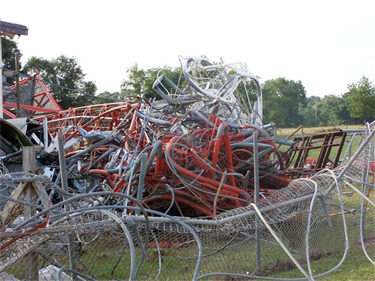 |
|
The greater portion of the WALB tower fell within a radius of 75'.
|
Controlled Demolition, Inc. of Maryland had been contracted to remove the WFXL-TV broadcast tower in Doerun, GA after it had been structurally damaged after an Army Chinook helicopter crashed near the top of the guyed tower last Thursday, killing four servicemen.
Four days of extensive engineering and equipment planning preceded today's demolition. Explosive charges had been placed on the tower's north nine guy wires so that the structure would fall to the south aided by the momentum of a 6,800-pound antenna that was already leaning 60-inches in that direction.
Cordoned off almost 2,000-feet from the towers, cameramen, reporters, technicians assisting CDI in the tower felling, and a handful of residents of this small South Georgia farming community of less than 900 people eagerly awaited the WFXL-TV tower's collapse. (View Video )
Demolition team members positioned themselves just outside the tower's fall radius at 1,100-feet where they would use equipment that would send an electrical charge to ignite the plastic explosives.
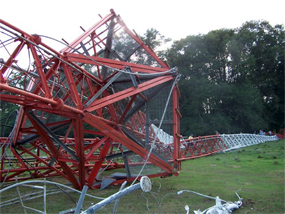 |
|
This hexagon colocation mount was barely
damaged following the tower's collapse.
|
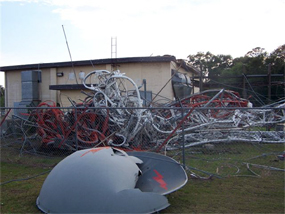 |
|
Dishes were scattered throughout area fields
that had just been cleared of debri
following the crash of a Chinook helicopter.
|
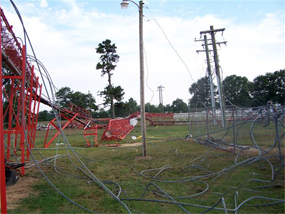 |
|
Guy wire was threaded throughout both
broadcast tower compounds.
|
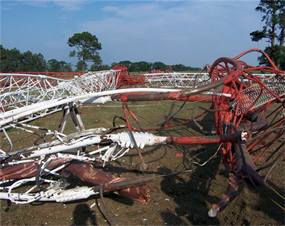 |
|
Some sections remained intact while others
were twisted beyond belief.
|
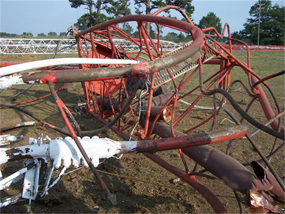 |
|
The top section of the PiRod tower had already
been severely damaged prior to the collapse.
|
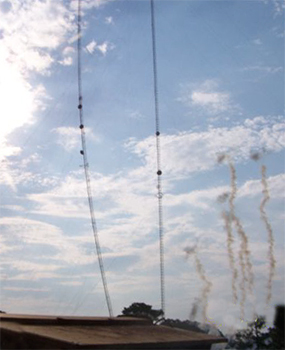 |
|
WFXL's tower appeared to be a picture perfect
drop until its top guy wire wrapped around
WALB's top guy wire, causing both towers to
fail during this evening's demolition.
|
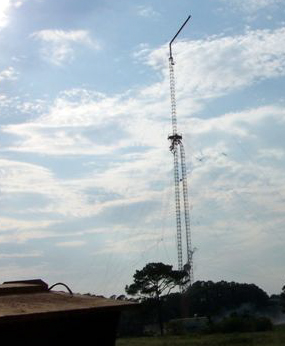 |
|
The Radian structure collapsed upon itself
after WFXL's antenna struck a guy wire. The
WALB antenna snapped in two prior to
coming in contact with the ground.
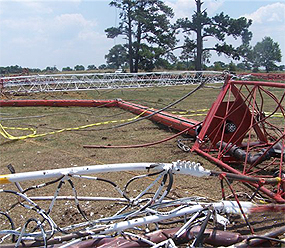 |
|
The two top sections of the WFXL tower were
cordoned off by the Army and will be taken
away for investigatory evidence in the fatal crash.
|
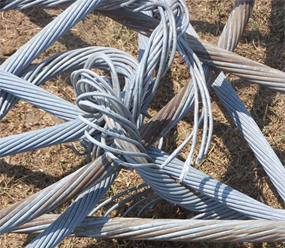 |
|
WALB's Achilles heel appeared to be this one
guy wire from WFXL that was severed correctly,
but wrapped around a guy wire on its fifth guy
level, creating an almost perfect knot. Along with
two other guywires that also joined the
galvanized fray, WFXL's tower became tethered
at the top and could not fall to the south as
planned by the demoltion engineers.
|
|
As the countdown began, reporters prepared their story's lead, camera operators zoomed in to capture both tall structures, and CDI employees and others assisting them embraced the excitement of the moment, knowing that they would accomplish a mission few people in the world would even take on, plus capture a Guinness record for felling the world's tallest tower with interlaced guy wires.
Spectators saw dark billowing clouds appear on multiple locations of the tower's north guy wires followed by the powerful sound of simultaneous explosions that rocked the area for miles. The tower remained upright momentarily, and then began a rigid fall south to open fields as planned.
Then it was apparent that something had gone terribly wrong as the tower bent almost ninety degrees towards the WALB tower at approximately the 360-foot level with the remainder of the structure beginning to fall vertically and slightly to the north.
Then WFXL's sister structure began to collapse vertically. WFXL's tower was on the ground within 15 seconds; 12 seconds later WALB's broadcast tower was intertwined in tons of twisted steel.
WALB's news anchor Dawn Hobby was shocked. Staring at the industrial carnage quickly disappearing under clouds of dust, she paused for a few seconds stating with a stutter, " I...we are all a little stunned. We did not really expect to see both towers come down like that."
Workers assisting in the demolition project shook their heads in disbelief.
Professionals who have reviewed WALB's footage and other videos believe that the fifth level guy wire on the WFXL tower was severed correctly by an explosive charge, but as the tower began to fall the wire curlicued around the the Radian tower's fifth guy level. Then WFXL's sixth and seventh level guy wires wrapped around the fifth guy level wire of WALB as well, preventing the top section from falling to the south as planned.
The top of the WFXL tower then proceeded to collapse almost vertically for a short period of time with the very top of the structure falling horizontally in a slight northern direction.
The shock loading to the Radian structure ripped off the guy lug and sheared off the leg at that location and the tower began to telescope upon itself, reminiscent of the Twin Tower collapses, aided by a heavy 20-foot combination torque arm and colocation platform without tenants.
No injuries were reported following the 6:32 p.m. accident.
Safety issues turned salvage operation into demolition
Following the helicopter crash, the station's 6,800-pound antenna would have had to be removed before it would be safe for tower maintenance workers to provide temporary guying support to replace a radial guy that was sheared during the crash.
However, helicopter companies related that it was too dangerous for them to provide the aerial services required.
The station's owner contracted with CDI to demolish the structure by collapsing it in an open field by using strategically placed explosive charges. CDI has designed and managed some of the world's largest implosions such as the Seattle Kingdome.
Although numerous tower erection companies have felled towers over the years by supervising a local blasting contractor, WFXL's structure created a unique safety concern.
WALB-TV's guyed tower sat approximately 150' away from the WFXL structure and was in danger of collapsing if the WFXL tower were to fall into it or across its supporting guy wires. Both towers are owned by Raycom Media of Montgomery, AL.
Both towers take the fifth
It was apparent that the explosive charges severed the guy wires as planned. Unfortunately, it appeared that the PiRod tower's number five guy wire wrapped itself around the Radian tower's fifth guy level and then two more whipped around that same guy.
A system of temporary guys on the bottom of the tower and at the 60-foot level using ¾" IWRC strand was used to secure the bottom of the tower to the southeast and southwest inner anchors so that it would not kick back to the north toward the equipment building when the north guy wires were severed.
A representative of CDI told a WALB reporter that he thought "the tower may likely lay out almost at its full height."
The tower was not set in the concrete foundation by design, but rested on top of it, being held in place by the structure's weight and the compression of the guy wires' tension. It was centered upon a short pier pin that allows slight rotation when severe wind conditions provide excess torque upon the tower.
Interlaced guy wires on WFXL's north anchor complicated the tower's demolition.
The tension from the remaining southeast and southwest guy wires was expected to pull the tower to the south with a momentum assist from the 3-1/2-ton broadcast antenna and the tower itself that was leaning 60-inches to the south as a result of the crash damage.
Test blasts were made yesterday upon similar guy wires. The tension on some of the guys on the southeast and southwest anchors of the tower had been adjusted.
A tower crew that had been working in Puerto Rico was flown in today to assist in inspecting the WALB tower once the WFXL structure was successfully felled. Instead, tomorrow morning they will be helping to assist in the investigation of the failure and the removal of both towers.
Both stations are operating from temporary transmitters in Albany, GA.
The loss of both of the towers, antennas and associated equipment is estimated to be $3 million. Both stations had plans later this month to install DTV antennas that are worth around $300,000 each.
WFXL is being sold to Barrington Broadcasting in a deal announced in March, however, neither party expects the structure's collapse will prevent the sale.
It is expected that a new tower will be constructed on the site containing a candelabra mount for multiple antennas to provide coverage for both WALB and WFXL. High intensity lighting may be considered for the new structure, although not required, to ensure that the tower will have a greater visibility to military and other aircfraft.
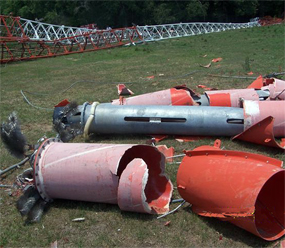 |
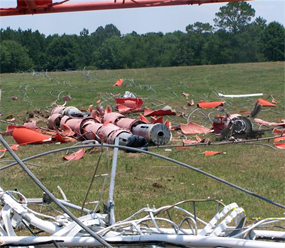 |
|
Like the rest of the structure, the 21,000-pound WALB antenna lay in ruins in the open field.
|
The WALB anntena broke in two without any apparent side load on the structure.
|
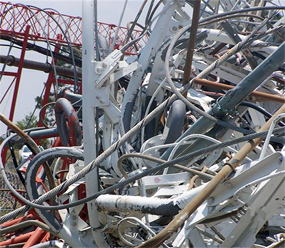 |
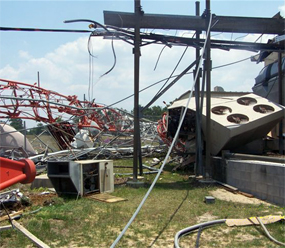 |
|
WALB's once proud steel lady was retired to a massive pile of bent braces and legs.
|
Both transmitter buildings received minimal damage from the felled towers.
|
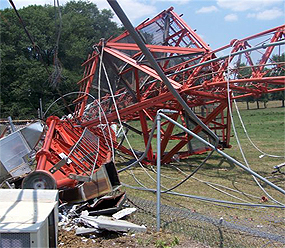 |
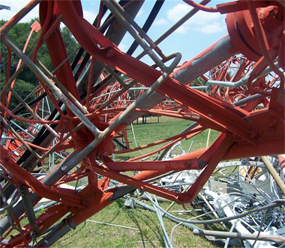 |
|
WALB's top colocation platform rests near the guy tower's base section.
|
Tons of twisted steel collapsed to the ground in less than 28 seconds.
|
|
The calm before the rain of steel
|
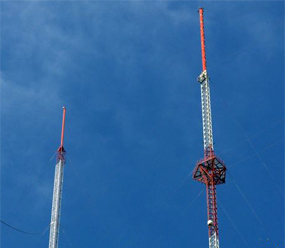 |
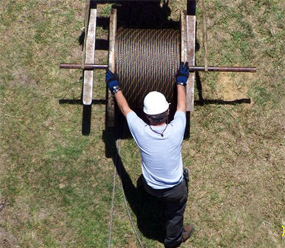 |
| WFXL's damaged tower (left) had interlaced guy wires with WABL's structure. |
Cable is loaded to be delivered to the anchor sites as additional guys. |
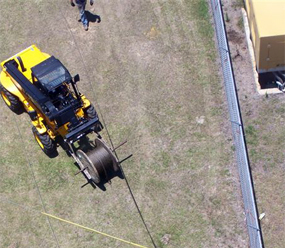 |
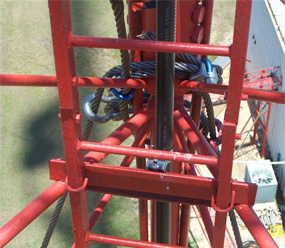 |
| The 3/4" temporary guys were intended to prevent the bottom section of the tower from moving. |
The bottom of the tower was also guyed at the 60' level to prevent it from jumping off the base. |
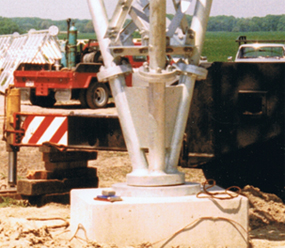 |
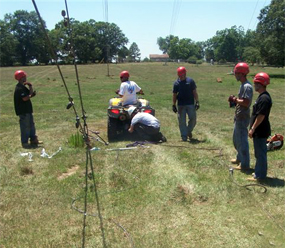 |
| Like this tower, WFXL's base sat upon a foundation only supported by a small pin. |
Crew members of Monarch Tower Services assisted in the demolition preparations. |
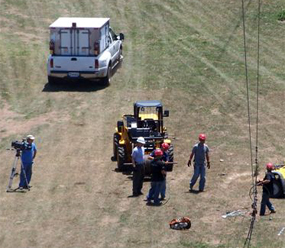 |
 |
| Videographers have been documenting the structure's demolition activities. |
Last minute checklists were completed before the tower's guy wires were cut using explosives. |
|